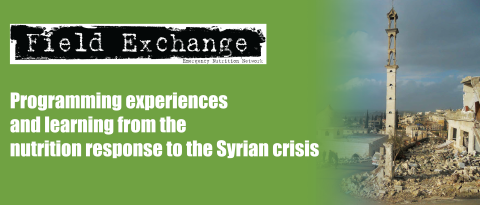Experiences and challenges of programming in Northern Syria
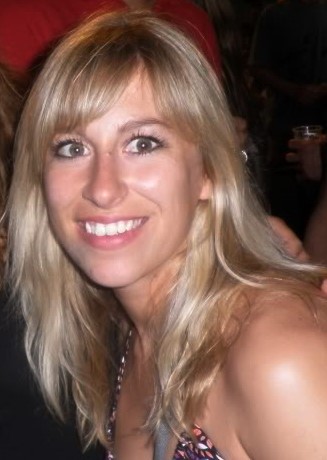 By Emma Littledike and Claire Beck
By Emma Littledike and Claire Beck
Emma Littledike has been the Health and Nutrition Manager for World Vision International on the Northern Syria response since September 2013. She was the Nutrition Sub-Working Group Lead February to May 2014.
Claire Beck is the Global Emergency Health, Nutrition and WASH Team Leader for World Vision International.
World Vision International (WVI) set up offices in southern Turkey in May 2013 and began work in Jarabulus and Manbij, Aleppo governorate, in response to the escalating violence in Syria and reports of large scale internal displacement. This article describes their experiences in supporting nutrition and related primary healthcare programming to internally displaced persons (IDPs) between May 2013 and April 2014.
Current IDP situation (May 2014)
 The total number of IDPs in Jarabulus is currently estimated at 22,875 and the total catchment population is approximately 68,000. The total number of IDPs in Manbij is estimated at 115,518 with an estimated catchment population of over 1 million. In Jarabulus, the camps are managed by an independent Syrian individual with strong relationships in the community. Informal camps have been established in collective community spaces such as schools and unfinished buildings. There are a greater number of informal camps in Manbij than Jarabulus. Organised and established camps in Manbij are managed by other INGOs. The majority of IDPs at the camps are from Homs, Hama and within Aleppo governorates.
The total number of IDPs in Jarabulus is currently estimated at 22,875 and the total catchment population is approximately 68,000. The total number of IDPs in Manbij is estimated at 115,518 with an estimated catchment population of over 1 million. In Jarabulus, the camps are managed by an independent Syrian individual with strong relationships in the community. Informal camps have been established in collective community spaces such as schools and unfinished buildings. There are a greater number of informal camps in Manbij than Jarabulus. Organised and established camps in Manbij are managed by other INGOs. The majority of IDPs at the camps are from Homs, Hama and within Aleppo governorates.
Early needs assessment
 At the time of initial assessment by WVI, only background nutrition data from Syria was available. Pre-crisis, Syria had a high global acute malnutrition (GAM) prevalence of 9.3%, stunting (23%) and underweight (10.3%). Micronutrient deficiencies in children 0-59 months were also prevalent: 29.2% anaemia, 8.7% Vitamin A deficiency and 12.9% iodine deficiency1 Pre-crisis infant and young child feeding (IYCF) practices were poor. National figures show a low initiation of breastfeeding within the first hour of birth (42.2%) and low exclusive breastfeeding amongst infants < 6 months (42.6%) (national survey, 2009)2. The percentage of children under 2 years who are not breast-fed is estimated at 10%. (2009)3. According to national data from 2006, the timely complementary feeding rate for children 6-9 months was 36.5% and the proportion of children 6-11 months who received the recommended minimum number of complementary foods per day was 20.8%4.
At the time of initial assessment by WVI, only background nutrition data from Syria was available. Pre-crisis, Syria had a high global acute malnutrition (GAM) prevalence of 9.3%, stunting (23%) and underweight (10.3%). Micronutrient deficiencies in children 0-59 months were also prevalent: 29.2% anaemia, 8.7% Vitamin A deficiency and 12.9% iodine deficiency1 Pre-crisis infant and young child feeding (IYCF) practices were poor. National figures show a low initiation of breastfeeding within the first hour of birth (42.2%) and low exclusive breastfeeding amongst infants < 6 months (42.6%) (national survey, 2009)2. The percentage of children under 2 years who are not breast-fed is estimated at 10%. (2009)3. According to national data from 2006, the timely complementary feeding rate for children 6-9 months was 36.5% and the proportion of children 6-11 months who received the recommended minimum number of complementary foods per day was 20.8%4.
In May 2013, an observational rapid area assessment was conducted by WVI in Jarabulus District, Aleppo governorate, Northern Syria to determine the need for and nature of health and nutrition interventions. The assessment team was made up of members of WVI’s Global Rapid Response Team. The target population for the assessment comprised internally displaced persons (IDPs) living both in one camp and amongst the host community (four additional camps were later established to meet the needs of the increased number of IDPs arriving). The priority needs voiced by the IDP and host community during the rapid assessment in Jarabulus, Aleppo governorate, were access to health services food, shelter and improved water, sanitation and hygiene (WASH) facilities for the camp residents and town inhabitants. Access to breast milk substitutes was also reported as a major issue.
Programme response
Primary health service support
WVIs immediate priority was to establish support to primary health care services. Health services were limited, consisting of a number of private doctors and a Qatari Red Crescent Field Hospital. The Syrian Arab Red Crescent clinic had not functioned for a while. IDPs could not afford to visit the private doctors and the camp management was unable to cover the cost of medicines for the residents. In conjunction with the local leadership, including the health committee, a small primary health care centre (PHC) was established in June 2013 next to the main camp in the area. A paediatrician, midwife and two nurses were hired to provide services, while a community mobiliser was hired to conduct health and nutrition assessments, to provide psychosocial support to women and to counsel on optimal IYCF in all the collective centres. An English and Arabic speaking coordinator linked expatriate and Syrian staff. All staff were qualified within the Syrian health system and selected with support from the local council and the health committee, who approved all appointees. Initially, expatriate staff visited the projects biweekly for ongoing training and support, but once the border was closed to expatriates in July 2013, all support, supervision and training was done either remotely through phone or skype access, or at the nearest border crossing on a bi-monthly basis. Few Syrian staff could cross the border to meet with management staff as this was time consuming and had to be well planned due to the busy work schedules in the field and the need to keep services running. Lack of identification documents was also an issue.
Building IYCF and SAM treatment capacity
Supports to IYCF and SAM treatment capacity were also provided. A planned IYCF training for all health and water, sanitation and hygiene (WASH) staff was postponed due to insecurity in the field. Instead, two doctors crossed the border for accelerated two day training. They were equipped with training materials and technical guidelines in Arabic language, and equipment to replicate it back in Syria during the afternoons when the clinic was closed. In practice, they could only deliver part of the training due to clinical demands. Guidance on the treatment of severe acute malnutrition (SAM) was also provided through technical resources and discussion. This proved sufficient for the paediatrician to begin treating acutely malnourished children who came to the clinic, rather than referring them for treatment at the hospital, which was 45 minutes travel by road and not always secure. F75 and F100 were made using locally available ingredients as commercial product was not available (see later for issues around supplies). Until then, the few children who presented at the clinic with SAM had complications and were referred to the hospital for medical treatment where no nutrition support was provided.
The initial rapid assessment was observational; it was not possible to collect data on feeding practices. Informed by background (national) data, all health staff were sensitized to the importance of exclusive breastfeeding. However the demand for BMS was high from the IDP and vulnerable host community. There was no BMS programme at the time although infant formula was available to purchase locally (see later under ‘challenges’). As a result of consultation with the governing group, WVI adapted the organisation’s Women, Adolescent and Young Child Space (WAYCS) model and instead of having separate dedicated spaces for women and children, an alternative more culturally appropriate approach was decided upon which was to set up WAYCS within clinic facilities. Staff began to hold small meetings for women in one of the clinic rooms to support them in breastfeeding and complementary feeding. It meant, however, that it was harder to include husbands and wider family in these sessions. To help overcome this, staff made tent-to-tent visits and collection centre visits to all pregnant and lactating women to provide support and education.
Further nutrition assessments
When WVI programmes began in June 2013, there were no current nutrition data available. By August 2013, two rapid mid upper arm circumference (MUAC) assessments had been conducted by two INGOs among children in Idleb and Ar raqqa governorates in northern Syria. Both found low prevalence rates of SAM (<0.4%) and moderate acute malnutrition (MAM) (<2.4%). Both assessments had limitations. The larger rapid assessment in Arraqqa5 was conducted alongside a measles vaccination campaign making it difficult to ensure quality data collection and the majority of children measured were <12 months. The rapid assessment in Idleb on 4,230 children did not provide enough information on the sampling methodology and household selection to determine how representative it was.
Given these limitations and the report of 30 cases of severe and moderate acute malnutrition to clinics between June and December 2013, WVI undertook an anthropometric survey amongst IDPs in Jarabulus district, Aleppo governorate, on 20th – 24th December 2013. Both weight-for-height z score (WHZ) and MUAC were assessed. Given the operational constraints, training on anthropometric assessment was compromised and relied on guidance documents, video links and a survey leader (paediatrician) with research experience in nutrition and anthropometric assessment. The assessment was carried out during a difficult time (snow and conflict) and the methodology had to be adapted to survey accessible areas. The prevalence of acute malnutrition was again found to be low: 2.6% global acute malnutrition (GAM), 0.5% SAM and 8.1% underweight (low weight for age). Prevalence of stunting was 22% (7.7% severe). A photograph of each child’s measurement was taken and examined for accuracy; the main limitation was an inaccurate adjustment for clothing weight (see images).
In September 2013, a joint scoping mission was carried out by the Global Nutrition Cluster (GNC) Rapid Response Team (RRT) consultant in Northern Syria to assess the nutrition situation
Scaling up services: small scale needs, large scale challenges
Case management of SAM
Whilst the prevalence of SAM was low, there was a need for small-scale treatment capacity. Existing capacity was weak given lack of training and low exposure of staff to WHO treatment protocols. The majority of in-patient facilities did not follow WHO protocols and used intravenous fluid as one of the main treatment methods for children with SAM and complications. Exceptions were specialised children’s hospitals in Aleppo and Damascus that are part of the Syrian Ministry of Health (MoH) and which follow WHO treatment protocols. In Syria, there was no commercially produced F100 or F75 available so locally prepared F75/F100 was used instead. An example of case management of a SAM case is given in Box 1.
In general, community based management of acute malnutrition is being explored but there is no community health worker network in existence so cases are being managed by a select few INGOs at their supported inpatient and outpatient facilities across the country. WVI is the only external (INGO) health provider in our operational areas in Northern Syria.
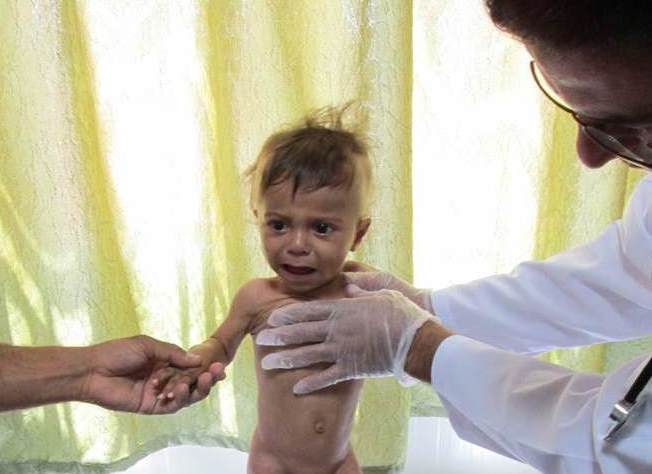 Box 1: Treatment of a case of SAM
Box 1: Treatment of a case of SAM
An infant presented to the clinic with acute watery diarrhoea having already received treatment with antibiotics and oral rehydration salts (ORS) from a private physician. The child had a history of chronic diarrhoea and had been formula fed since birth (never breastfed). The child had a WHZ <-3 and MUAC 11cm at 9.5 months of age. The infant showed signs of marasmus and dehydration. He had a fast pulse and dry hair. His weight on presentation was 5.5kg (a weight recorded at the private clinic was 6kg).
The staff began treatment by stopping the course of antibiotics, given the lack of evidence for the infection diagnosed. For the first two days, ReSoMAL solution was provided (5ml/kg =30ml every half an hour). This was prepared as 5% Dextrose, 1.8g of sodium chloride and 1.5g of potassium chloride in one litre of water. F100 was also given and it was prepared as: 80g powdered full fat milk, 45g olive oil, 50g cane sugar, 1g potassium chloride, 0.5g magnesium citrate, 2mg copper acetate and 20mg of zinc acetate dissolved in 1 litre of boiling water and set to cool. The F100 was given to the child in 60ml doses every 2 hours. Vitamin A was also given for 2 days. The clinic staff reported that they cannot prepare F75 as there is no skimmed milk.
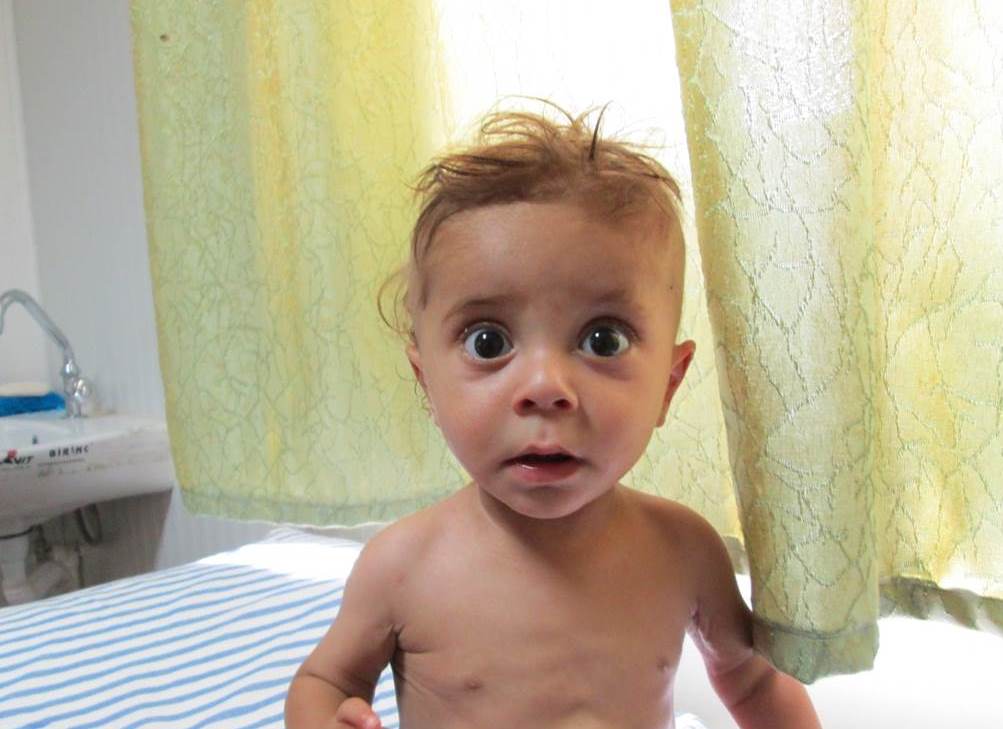 On the fourth day they gave the child Bactrim syrup and on the 8th day, gave iron. The child recovered and then maintained his pre-hydration weight (6kg) during this stabilisation period.
On the fourth day they gave the child Bactrim syrup and on the 8th day, gave iron. The child recovered and then maintained his pre-hydration weight (6kg) during this stabilisation period.
During the following 10 days, the quantity of F100 was increased and under supervision, he proceeded to gain weight at a rate of 15g/kg/day (90g/day). For another 20 days, the child was managed at home with increased F100; his father was capable of preparing F100. The child’s weight increased to 8kg and MUAC increased to 12.5cm. He was discharged on lactose free milk until one year of age and then transferred to full fat milk (reconstituted NIDO). The child now drinks full cream milk, one boiled egg, and fruit daily. He returns to the clinic for regular weigh in.
Source: INGO worker
Due to cultural norms and medical hierarchy, it is also proving difficult for humanitarian agencies to support in-patient facilities to improve the treatment of SAM with training and support. Designated in-patient referral facilities need to be identified in each governorate and there is a requirement for training events inside Syria to be delivered by a highly qualified consultant. Many health personnel that are both employed by the regime, working independently or for an INGO are unable to cross the border into Turkey without a passport. Travel to Aleppo to acquire a passport carries substantial safety risk. The need was therefore identified for a strong distance learning training package comprised of narrated videos in Arabic that could be stored on USBs and disseminated in-country. Whilst this is inferior to practical ‘on the job’ training at in-patient facilities, it is perhaps the only way to improve treatment, particularly in areas with poor access such as Deir ez zor and Homs.
Of note, we have seen a higher caseload of malnutrition cases in the past two months. There have been around 30 cases of malnutrition (24 moderately malnourished and six severely malnourished) identified at the clinics.
 Therapeutic food supplies
Therapeutic food supplies
Establishing a supply of therapeutic and supplementary feeding products has been problematic. Our agency could find no local equivalents of RUTF in Turkey and acquiring therapeutic feeding products from reputable suppliers has been difficult. The customs cost to import products is excessive. For example, an RUTF order worth $650 carried a customs clearance cost of $5000 on top of a $1500 shipment cost. Increasing the order quantity did not improve the cost efficiency. Our agency managed to find a supplier who helped to secure customs clearance free of charge as a one-off gesture of support. However supplies had to be shipped straight into Syria (since the agency was not registered in Turkey and so goods could not be stored in-country). Thus it was not possible to share the supplies with other Turkey-based INGOs and Syrian NGOs as planned. Border closures further prevented staff sending supplies back to Turkey to share with other agencies. Importing and storing products in Turkey requires agencies to be registered as organisations undertaking medical activities. A number of agencies are not yet registered, despite their efforts, due to the length of time required to submit and get feedback from applications.
Access to health care: the role of the private sector
In Manbij city, Aleppo governorate, there are 289 doctors working privately providing high quality care. IDPs are not able to pay the commercial prices for treatment at private clinics. Many primary and secondary clinic healthcare staff provide free consultations or a negotiated lower payment rate but given financial and time constraints, they are only able to see a small number of patients per day. WVI has recently embarked on a 1 year pilot of a small-scale healthcare voucher system using the private sector to provide quality services to IDPs who had little or no household income (April 2014 – 31st March 2015).
The pilot targets children under 5 years in select areas of Manbij. They will receive a voucher entitling them to one consultation at any private clinic and medicine from a pharmacy over the 12 month project period. At WVI’s primary healthcare facilities in Jarabulus and Manbij, children under 5 years have the highest proportion of respiratory tract infections, gastrointestinal diseases and acute malnutrition. They are also the most vulnerable group to acquire diseases with outbreak potential such as acute jaundice syndrome, acute watery diarrhoea, polio and measles.
The caregiver presents the voucher to an accredited primary or secondary healthcare provider that they select, along with the eligible child’s IDP registration card. After the consultation, the provider then submits a claim to the agency to obtain reimbursement for the services provided with all required paperwork, including detailed patient records. If the healthcare provider issues a prescription, the caregiver can obtain medicine from an accredited pharmacist by presenting it along with the voucher and the eligible child’s IDP registration card.
Healthcare providers will receive an induction on the voucher system detailing the beneficiary age group eligible to receive treatment, records required for verification and how they can claim. Additionally, a number of vouchers will be issued from the agency’s PHCs in Manbij to patients in need of quality secondary healthcare treatment from specialist doctors.
A demand-side financing scheme such as this is expected to reduce financial barriers to access and therefore should improve utilisation of health facilities by IDPs. Since the voucher scheme allows the caregiver to choose the providers, this should encourage quality health care services through increased competition in the market. Targeting children under 5 years should also reduce the possibility of voucher selling and misuse. By design, revenue earned by a health facility from IDPs is directly proportional to the number seen. Therefore, this scheme should enhance the quality and quantity of targeted private healthcare services. WVI will monitor quality of consultations randomly to ensure clinics signed up to the scheme are providing adequate services.
BMS supplies and support
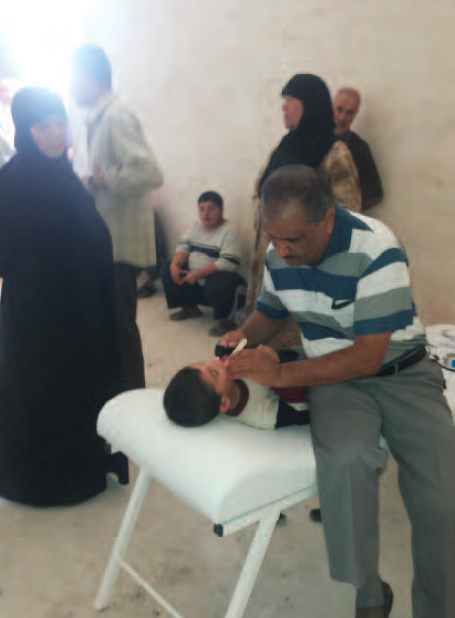 As reflected in the early needs assessment, the demand for BMS was high from the community; a reflection of its common use. Uncontrolled and untargeted distributions of BMS remain common, however determining the extent to which this is happening is extremely difficult, especially given that the response is managed remotely. Some actions have been taken at coordination level to try and minimise risks (see postscript).
As reflected in the early needs assessment, the demand for BMS was high from the community; a reflection of its common use. Uncontrolled and untargeted distributions of BMS remain common, however determining the extent to which this is happening is extremely difficult, especially given that the response is managed remotely. Some actions have been taken at coordination level to try and minimise risks (see postscript).
The need for support with safe artificial feeding was identified as particularly important in areas receiving large supplies of BMS. Information, Education and Communication (IEC) materials (posters and flyers) were provided to all agencies on how to prepare formula safely. There was one observational report of infant formula being distributed into cups from a large tank / container and handed out, so in addition to the IEC, the working group also identified the need for safe feeding kits to be distributed.
Infant formula availability in the markets in Syria has been very sporadic and prices are higher than before the conflict. It is not affordable for IDPs and vulnerable host communities. Prices range from $7-10 for 1kg in Jarabulus and Manbij when it is available. A small amount is available in pharmacies but it is not enough to meet the needs of the communities. It is also available in some markets. Currently (May 2014) there is almost none available. WVI has not procured infant formula as the programming focus was on breastfeeding support and procurement and transport of medicines and supplies from Turkey has been a huge challenge.
 Innovations
Innovations
Remote training delivery
There have been many challenges in delivering training, such as lack of Arabic speaking trainers available in Turkey, border closures preventing travel, and limitations on the number of participants at venues. A training of trainers relies upon staff prioritising delivering training in-country which may not be feasible depending on the area, workload and available resources. This led WVI to develop a distance learning package in the style of Khan Academy videos6. Also, WVI has worked with a regional GNC/UNICEF IYCF consultant to produce a harmonised translated IYCF training package using training materials from many NGO nutrition actors working in the region. A series of videos on all nutrition topics, particularly IYCF-E and nutrition in emergencies, will be produced on USBs for distribution to all NGOs and passed onto Syrian health staff. Pre- and post-training tests are also being developed and added to the USBs so that agencies can check and verify that the staff have watched the videos and understood the content. Given the high turnover of medical staff in many areas, this also ensures that training new staff is not an additional burden.
Discussion
Remote management led to the development of robust data collection mechanisms which were set up in the early stages of the programme in September. A Health Information Management System (HMIS) was developed to monitor consultations for all morbidities including malnutrition. The HMIS automatically calculates incidence, prevalence and case fatality rates per geographic area. Data can be cross checked with patient records. Data entry is simple for field staff and data collation is automatic. There is a need for a standardised database system which can be used by all INGOs and Syrian NGOs and patient ID cards. Given the difficulties with ensuring a consistent supply of medicines, establishing a strong pharmacy system is also integral to provide inventory reports and determine needs ahead of time. The HMIS and pharmacy system combined enabled us to produce an annual forecast of pharmaceutical products required per clinic on a monthly basis, taking seasonal fluctuations in morbidities into consideration. In addition to data management systems, beneficiary feedback mechanisms were also important to ensure quality of service provision. Putting these standardized systems into place in each project early was essential to gain an indepth understanding and provide a greater level of support.
Remote management calls for strong and consistent communication via telephone daily at designated times, and regular trainings (in Turkey, online and in Syria). Given access to programmes was not feasible, the building of health worker managerial skills became as integral as health technical guidance, particularly for Health Coordinators in each location. Provision of training about humanitarian standards and regulations was also critical given all health staff had no prior experience of working on a humanitarian programme. Creativity was critical to ensure staff received quality training given the difficulties with border closure and lack of passports. Training delivery was through a variety of methods including Webex, training of trainers, videos and contracting Syrian consultants. Trainings are often conducted in a large community space and videoed for the benefit of new staff who may join in the future.
Effective contingency planning was another important lesson learned, given conflict and escalations in fighting have led to hibernation (temporary suspensions of activities) and border closures. These factors have complicated both movement of staff into and out of Syria and distribution of medical and therapeutic food supplies. The temporary cessation of clinic activities had a huge impact on the population as there are no other health providers. We learned that detailed contingency planning is essential. Supplies need to be pre-positioned and stored appropriately and staff need to have completed security training and be thoroughly briefed on security standard operating procedures.
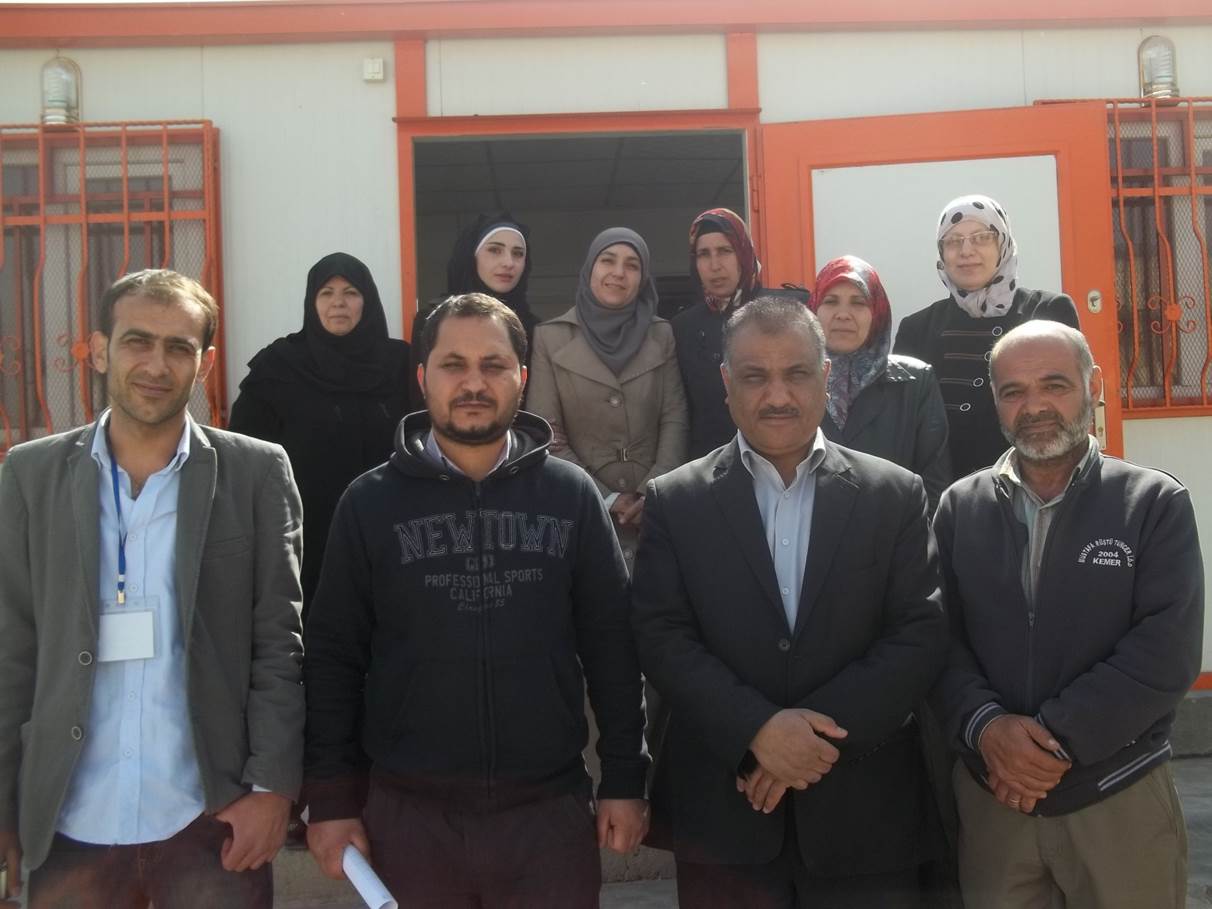 Given the difficulties with procurement for unregistered agencies and transportation of supplies amidst border closure, early hire of a medical procurement specialist is essential to support supply chain establishment and management. The hiring of pharmacists within Syria to dispense medicines to patients and manage and plan stock from an early stage was also essential. Our INGO has procured drugs from Turkey and within Syria. Sourcing drugs from within Syria can be a challenge for staff since not all pharmacies have the amount in stock that is required, forcing them to visit many times and buy piecemeal. Research also needs to be conducted evaluating the quality of medicines and supplies available for purchase inside Syria. WVI has developed an assessment tool to gain more information about production, regulation and gauge the opinion of Syrian pharmacists and health staff about the quality of medicines. Procurement and distribution of essential primary health care medicines across the border has posed significant challenges. Supplies have had to be sent out with biscuit shipments and once across the border, transporting them within areas affected by conflict to the project sites has been extremely difficult.
Given the difficulties with procurement for unregistered agencies and transportation of supplies amidst border closure, early hire of a medical procurement specialist is essential to support supply chain establishment and management. The hiring of pharmacists within Syria to dispense medicines to patients and manage and plan stock from an early stage was also essential. Our INGO has procured drugs from Turkey and within Syria. Sourcing drugs from within Syria can be a challenge for staff since not all pharmacies have the amount in stock that is required, forcing them to visit many times and buy piecemeal. Research also needs to be conducted evaluating the quality of medicines and supplies available for purchase inside Syria. WVI has developed an assessment tool to gain more information about production, regulation and gauge the opinion of Syrian pharmacists and health staff about the quality of medicines. Procurement and distribution of essential primary health care medicines across the border has posed significant challenges. Supplies have had to be sent out with biscuit shipments and once across the border, transporting them within areas affected by conflict to the project sites has been extremely difficult.
A thorough understanding of the situation in terms of health staff and facilities existing in the areas and resources available is very important. Establishing an ambulance was a real challenge given there were no equipped suitable vehicles for use. A large van, which had been badly damaged and abandoned in the conflict, was donated by local authorities and refurbishing and fixing the vehicle was a major effort. Procurement of specialist ambulance equipment from Turkey was also extremely time consuming and problematic. Both of these factors led to a time delay in the establishment of ambulance services which was not anticipated at the beginning of the programme. Gaining knowledge of the health care system generated the idea for voucher provision instead of the establishment of more clinics which may not be sustainable. It was deemed more effective for a larger number of doctors to remain in their private clinics and benefit from supplementary pay to treat IDPs than for a smaller number to give up their work for a position at a WVI clinic which may not be able to run sustainably. An indepth assessment of the capacity of all private clinics and pharmacists is currently being conducted.
For more information, contact: Emma Littledike, email: Emma.littledike@hotmail.co.uk
1 Revised Syria Humanitarian Assistance Response Plan (SHARP), Syrian Arab Republic, January- December 2013
2 Syrian Family Health Survey, 2009
3 Figure estimated from area graphs in Trends in Infant Feeding Patterns, January 2009
4 Multiple Indicator Cluster Survey, Syrian Arab Republic, 2006
5 The actual number of children measured is not confirmed.


